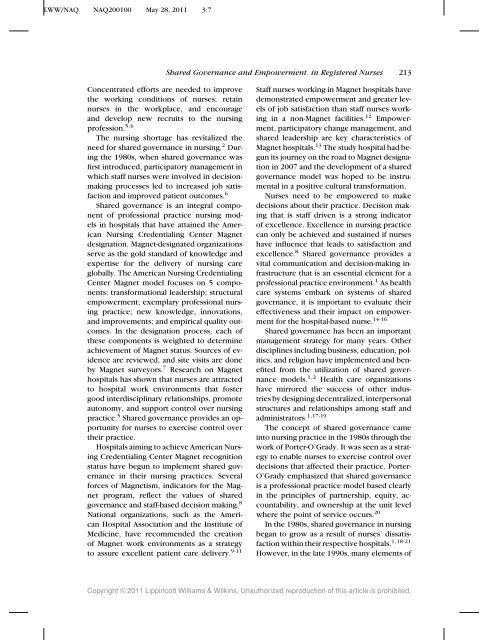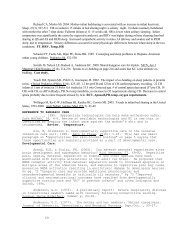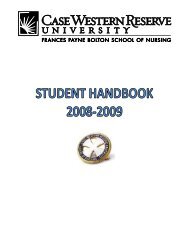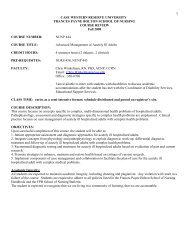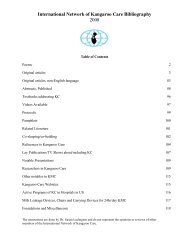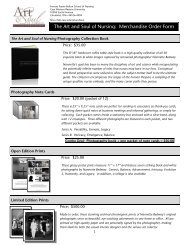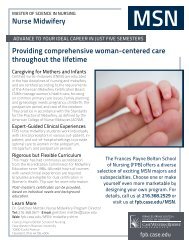Shared Governance and Empowerment in Registered Nurses ...
Shared Governance and Empowerment in Registered Nurses ...
Shared Governance and Empowerment in Registered Nurses ...
You also want an ePaper? Increase the reach of your titles
YUMPU automatically turns print PDFs into web optimized ePapers that Google loves.
LWW/NAQ NAQ200100 May 28, 2011 3:7<br />
<strong>Shared</strong> <strong>Governance</strong> <strong>and</strong> <strong>Empowerment</strong> <strong>in</strong> <strong>Registered</strong> <strong>Nurses</strong> 213<br />
Concentrated efforts are needed to improve<br />
the work<strong>in</strong>g conditions of nurses, reta<strong>in</strong><br />
nurses <strong>in</strong> the workplace, <strong>and</strong> encourage<br />
<strong>and</strong> develop new recruits to the nurs<strong>in</strong>g<br />
profession. 5,6<br />
The nurs<strong>in</strong>g shortage has revitalized the<br />
need for shared governance <strong>in</strong> nurs<strong>in</strong>g. 2 Dur<strong>in</strong>g<br />
the 1980s, when shared governance was<br />
first <strong>in</strong>troduced, participatory management <strong>in</strong><br />
which staff nurses were <strong>in</strong>volved <strong>in</strong> decisionmak<strong>in</strong>g<br />
processes led to <strong>in</strong>creased job satisfaction<br />
<strong>and</strong> improved patient outcomes. 6<br />
<strong>Shared</strong> governance is an <strong>in</strong>tegral component<br />
of professional practice nurs<strong>in</strong>g models<br />
<strong>in</strong> hospitals that have atta<strong>in</strong>ed the American<br />
Nurs<strong>in</strong>g Credential<strong>in</strong>g Center Magnet<br />
designation. Magnet-designated organizations<br />
serve as the gold st<strong>and</strong>ard of knowledge <strong>and</strong><br />
expertise for the delivery of nurs<strong>in</strong>g care<br />
globally. The American Nurs<strong>in</strong>g Credential<strong>in</strong>g<br />
Center Magnet model focuses on 5 components:<br />
transformational leadership; structural<br />
empowerment; exemplary professional nurs<strong>in</strong>g<br />
practice; new knowledge, <strong>in</strong>novations,<br />
<strong>and</strong> improvements; <strong>and</strong> empirical quality outcomes.<br />
In the designation process, each of<br />
these components is weighted to determ<strong>in</strong>e<br />
achievement of Magnet status. Sources of evidence<br />
are reviewed, <strong>and</strong> site visits are done<br />
by Magnet surveyors. 7 Research on Magnet<br />
hospitals has shown that nurses are attracted<br />
to hospital work environments that foster<br />
good <strong>in</strong>terdiscipl<strong>in</strong>ary relationships, promote<br />
autonomy, <strong>and</strong> support control over nurs<strong>in</strong>g<br />
practice. 5 <strong>Shared</strong> governance provides an opportunity<br />
for nurses to exercise control over<br />
their practice.<br />
Hospitals aim<strong>in</strong>g to achieve American Nurs<strong>in</strong>g<br />
Credential<strong>in</strong>g Center Magnet recognition<br />
status have begun to implement shared governance<br />
<strong>in</strong> their nurs<strong>in</strong>g practices. Several<br />
forces of Magnetism, <strong>in</strong>dicators for the Magnet<br />
program, reflect the values of shared<br />
governance <strong>and</strong> staff-based decision mak<strong>in</strong>g. 8<br />
National organizations, such as the American<br />
Hospital Association <strong>and</strong> the Institute of<br />
Medic<strong>in</strong>e, have recommended the creation<br />
of Magnet work environments as a strategy<br />
to assure excellent patient care delivery. 9-11<br />
Staff nurses work<strong>in</strong>g <strong>in</strong> Magnet hospitals have<br />
demonstrated empowerment <strong>and</strong> greater levels<br />
of job satisfaction than staff nurses work<strong>in</strong>g<br />
<strong>in</strong> a non-Magnet facilities. 12 <strong>Empowerment</strong>,<br />
participatory change management, <strong>and</strong><br />
shared leadership are key characteristics of<br />
Magnet hospitals. 13 The study hospital had begun<br />
its journey on the road to Magnet designation<br />
<strong>in</strong> 2007 <strong>and</strong> the development of a shared<br />
governance model was hoped to be <strong>in</strong>strumental<br />
<strong>in</strong> a positive cultural transformation.<br />
<strong>Nurses</strong> need to be empowered to make<br />
decisions about their practice. Decision mak<strong>in</strong>g<br />
that is staff driven is a strong <strong>in</strong>dicator<br />
of excellence. Excellence <strong>in</strong> nurs<strong>in</strong>g practice<br />
can only be achieved <strong>and</strong> susta<strong>in</strong>ed if nurses<br />
have <strong>in</strong>fluence that leads to satisfaction <strong>and</strong><br />
excellence. 8 <strong>Shared</strong> governance provides a<br />
vital communication <strong>and</strong> decision-mak<strong>in</strong>g <strong>in</strong>frastructure<br />
that is an essential element for a<br />
professional practice environment. 1 As health<br />
care systems embark on systems of shared<br />
governance, it is important to evaluate their<br />
effectiveness <strong>and</strong> their impact on empowerment<br />
for the hospital-based nurse. 14-16<br />
<strong>Shared</strong> governance has been an important<br />
management strategy for many years. Other<br />
discipl<strong>in</strong>es <strong>in</strong>clud<strong>in</strong>g bus<strong>in</strong>ess, education, politics,<br />
<strong>and</strong> religion have implemented <strong>and</strong> benefited<br />
from the utilization of shared governance<br />
models. 1,2 Health care organizations<br />
have mirrored the success of other <strong>in</strong>dustries<br />
by design<strong>in</strong>g decentralized, <strong>in</strong>terpersonal<br />
structures <strong>and</strong> relationships among staff <strong>and</strong><br />
adm<strong>in</strong>istrators 1,17-19<br />
The concept of shared governance came<br />
<strong>in</strong>to nurs<strong>in</strong>g practice <strong>in</strong> the 1980s through the<br />
work of Porter-O’Grady. It was seen as a strategy<br />
to enable nurses to exercise control over<br />
decisions that affected their practice. Porter-<br />
O’Grady emphasized that shared governance<br />
is a professional practice model based clearly<br />
<strong>in</strong> the pr<strong>in</strong>ciples of partnership, equity, accountability,<br />
<strong>and</strong> ownership at the unit level<br />
where the po<strong>in</strong>t of service occurs. 20<br />
In the 1980s, shared governance <strong>in</strong> nurs<strong>in</strong>g<br />
began to grow as a result of nurses’ dissatisfaction<br />
with<strong>in</strong> their respective hospitals. 1,18-21<br />
However, <strong>in</strong> the late 1990s, many elements of<br />
Copyright © 2011 Lipp<strong>in</strong>cott Williams & Wilk<strong>in</strong>s. Unauthorized reproduction of this article is prohibited.


